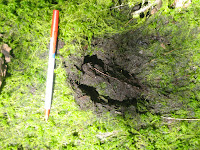“One way to open your eyes is to ask yourself, 'What if I had never seen this before? What if I knew I would never see it again?"-Rachel Carson
You may be wondering where and what the Tamposi Land is:
These are the questions that structured our project:Commonly known as the Tamposi Land you may have also heard it referred to as the Barrington Headwaters or the Samuel A. Tamposi Water Supply Reserve. Located in Barrington, New Hampshire, the Tamposi stretches over 1400 acres of land and over the last 300 years has been used for different purposes. Most recently, approximately 7 years ago, the town of Barrington bought the land from the Tamposi family. In a step to further protect the land, Barrington was given $740,000 grant from a water supply protection program. In 2001 Barrington accepted the deed for the property and the Tamposi is now a designated water supply protection area. It supplies the water to many surrounding communities including Durham.


Group Vernal
Our study site on the Tamposi (see picture of ArcView map) was located about half a mile down from the end of Tibbets Road, just to the North. Most of the vernal pool, which was dry, was determined by our group visually by, sphagnum moss and depression of the land. There were two small pools still filled with water and we aptly named them Laverne and Shirley. We spent time observing this area which we agreed to be the perimeter. Our first goal was to determine that what we were studying was in fact a vernal pool.
- What makes this site/place important?
- Why does it need to be protected/known?
- How will you/people connect to this place?
Vernal Pools Importance
The MOOSE (and other mammals):
Group Vernal trekked out to the site 6 times and just from daily, initial observation it was apparent that we had a visitor/visitors. Moose! The first week new tracks were visibly noticeable each day walking through Laverne and Shir ley. The second week we didn't see any fresh tracks which we thought could be contributed to our disturbance on the area. However, after we had left the site alone he/she was back. We could deduce from this that this vernal pool was important to the moose, either as a watering hole or an area rich in food. Moose feed on leaves, twigs, and buds of hardwood and softwood trees and shrubs. There was plenty of all this around....they also left us a present nearby.
ley. The second week we didn't see any fresh tracks which we thought could be contributed to our disturbance on the area. However, after we had left the site alone he/she was back. We could deduce from this that this vernal pool was important to the moose, either as a watering hole or an area rich in food. Moose feed on leaves, twigs, and buds of hardwood and softwood trees and shrubs. There was plenty of all this around....they also left us a present nearby.
Group Vernal trekked out to the site 6 times and just from daily, initial observation it was apparent that we had a visitor/visitors. Moose! The first week new tracks were visibly noticeable each day walking through Laverne and Shir
 ley. The second week we didn't see any fresh tracks which we thought could be contributed to our disturbance on the area. However, after we had left the site alone he/she was back. We could deduce from this that this vernal pool was important to the moose, either as a watering hole or an area rich in food. Moose feed on leaves, twigs, and buds of hardwood and softwood trees and shrubs. There was plenty of all this around....they also left us a present nearby.
ley. The second week we didn't see any fresh tracks which we thought could be contributed to our disturbance on the area. However, after we had left the site alone he/she was back. We could deduce from this that this vernal pool was important to the moose, either as a watering hole or an area rich in food. Moose feed on leaves, twigs, and buds of hardwood and softwood trees and shrubs. There was plenty of all this around....they also left us a present nearby.
A Habitat for the Little Guys:
This pool, although towards the end of its wet season, was teeming  with life. We saw a number of amphibians, amphipods, and arthropods. The most notable species observed was the wood frog (see photo to left), which are most indicative to vernal pools. The resident amphipods, the water scorpions and the giant water bug, were present too. We were all in agreement that we would NOT want to be in the same pool as the giant water bug, or more commonly known as the toe-biter! We observed a number of arthropods such as backswimmers (munching away on isopods), predacious diving beetles, and water boatmen.
with life. We saw a number of amphibians, amphipods, and arthropods. The most notable species observed was the wood frog (see photo to left), which are most indicative to vernal pools. The resident amphipods, the water scorpions and the giant water bug, were present too. We were all in agreement that we would NOT want to be in the same pool as the giant water bug, or more commonly known as the toe-biter! We observed a number of arthropods such as backswimmers (munching away on isopods), predacious diving beetles, and water boatmen.
 with life. We saw a number of amphibians, amphipods, and arthropods. The most notable species observed was the wood frog (see photo to left), which are most indicative to vernal pools. The resident amphipods, the water scorpions and the giant water bug, were present too. We were all in agreement that we would NOT want to be in the same pool as the giant water bug, or more commonly known as the toe-biter! We observed a number of arthropods such as backswimmers (munching away on isopods), predacious diving beetles, and water boatmen.
with life. We saw a number of amphibians, amphipods, and arthropods. The most notable species observed was the wood frog (see photo to left), which are most indicative to vernal pools. The resident amphipods, the water scorpions and the giant water bug, were present too. We were all in agreement that we would NOT want to be in the same pool as the giant water bug, or more commonly known as the toe-biter! We observed a number of arthropods such as backswimmers (munching away on isopods), predacious diving beetles, and water boatmen.Giant Water Bug, Backswimmer, and Water Scorpion:



The Vegetation:
A major identifier to vernal pool existence is the vegetation within the pool and the surrounding area. With Lara's help we conducted a vegetation study. We analyzed two plots within what we determined is the vernal pool area and one in the upland area. Our plots were 5m in diameter round. We identified the top three dominant tree, shrub, and herbaceous species in each plot and used a National Wetland Indicator status list to determine if we were within are vernal pool perimeter. And we were right! Plot one and two were within the vernal pool because the majority were obligate and faculatative wetland species! Some of the common species we saw in plot one and two were highbush blueberry, common winterberry holly, and sphagnum.



Our upland plot, which we determined it to be, contained hemlock, lowbush blueberry, and bracken fern that are on the list as faculatative upland species.



Know and Protect
The reasons above (mammals, little guys, and the vegetation) are just three great motives to stop and think..."vernal pools are home to many more species then I would have first assumed!" By informing yourselves and others on this wondrous ecosystem you are taking the first step in protecting these lives. These environments are home to many terrestrial and semi-aquatic species because they are able to breed and hatch their young without fish predation. We saw many tadpoles still living within these pools! Plus, the vernal pools are home to many vegetative species where they can flourish. Next time you are walking through a wooded forest in the NE be aware of what you are stepping on and appreciate that it is not just there for you but for all of us, from the little salamander to dragonflies to moose. It is there for us to appreciate. This can be said for ecosystems everywhere!
Connecting to the Place
Group Vernal connected with their study area by educating and observing the area. Our biggest day came when we took a sample scoop from Laverne and Shirley and just watched the mini ecosystem play out. It was amazing how slowing down and taking the time to observe made a world of difference. In a few minutes we were watching backswimmers dive on isopods, water boatmen going after phantom midges, and a water scorpion stealthily sneaking to the surface. We immediately became connected to the area and respected the lives these species lived, no matter how big or how small they were. Take the time to connect, in what ever way you feel necessary (preferably without human disturbance), to your environment.
As a group we came up with a working definition of a vernal pool:
Vernal pools, also known as ephemeral pools, are bodies of standing water which typically fill in the spring, dry up in the hottest summer months, and may or may not begin to refill in the autumn. They are filled by snow melt, runoff, precipitation, and rising ground water. They may hold water for as little as two months and as long as several years at a time. Vernal pools, by definition, are devoid of fish and thus provide essential habitat for terrestrial and semi-aquatic species that require them for breeding and the hatching of young by the fish predation.
Here are a few links that you may want to check out for more information on vernal pools:
Thank you for stopping by and feel free to respond with questions or comments.
Here are a few links that you may want to check out for more information on vernal pools:
Thank you for stopping by and feel free to respond with questions or comments.














